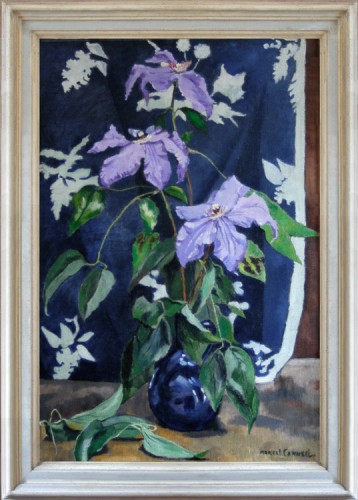This large, ornamental panel betrays Canneel’s origins as a decorative painter: the close harmony of colours across the canvas; the sweeping lines of stalk and leaves; the forms which echo and repeat each other; the background fabric, with its own mirroring pattern. The work as a whole is beautifully integrated: an almost abstract, musical composition of shapes, tones and reflections. Canneel’s flowerpieces stand out from amongst his landscapes, individual and beautifully constructed. A related work is Composition aux tournesols of 1941, which has the same disciplined harmony of colour and shape.
Biographical details
Marcel Canneel was born in Ghent in 1894, one of the Canneel family of artists. His brothers Eugène, Jean-Marie and Jules were also painters. Marcel seems to have taught himself to paint, beginning his career as a decorative artist, and later moving to figure and landscape painting in a Post-Impressionist style. His landscapes are local to his home in Brabant, but he also painted in the South of France and the Ardennes, producing scenes of villages set amidst tumbling hills, roofscapes on wooded slopes and rural streets. He also painted coastal landscapes and harbours. His palette varies from light and colourful, in the vein of Cézanne’s Mediterranean villages, to earthy and somber, in the style of early Van Gogh. In his twenties, during the First World War, he painted even whilst serving at the front. He had exhibitions of his work in 1916, 1917 and 1918; in 1918 he also joined La section artistique. After the war, he taught painting at the Académie de Saint-Gilles.
Works in public collections include paintings in the Musée d’Ixelles.


